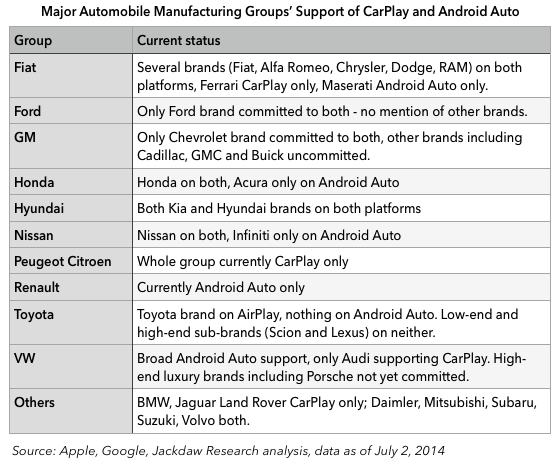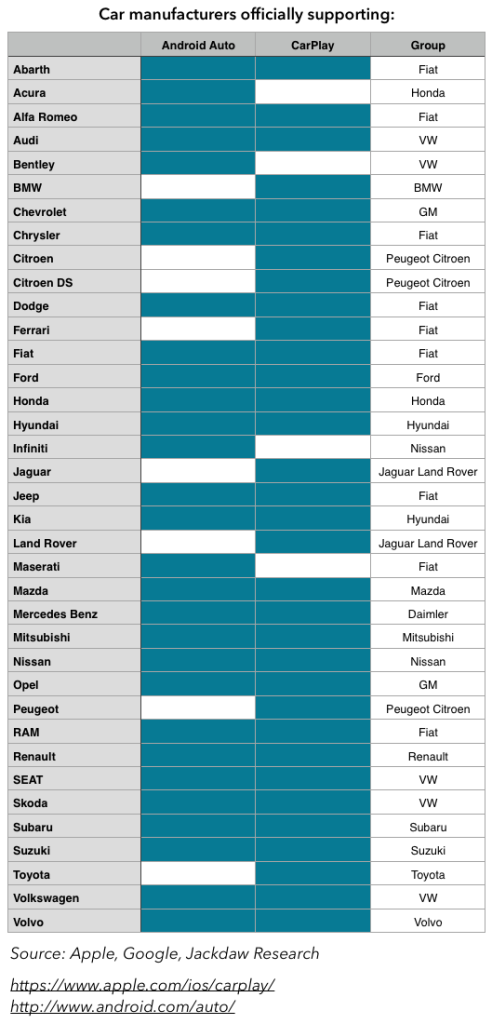Apple announced on Tuesday that it had added several new auto manufacturers to its list of partners for its CarPlay automotive platform. Given Google’s official launch of Android Auto last week, we now have two major platforms looking to do very similar things in the car: namely, extending certain smartphone functions to the in-car display. I thought it would be useful to have a quick look at how the two platforms are shaping up in terms of their support from major automobile manufacturers.
Here’s a summary of support by the major manufacturing groups . A full list by brand follows at the bottom of the post.
 What’s striking is that there is no clear pattern between the two sets of companies. Both companies have just under 30 total brands supporting their platform, and there’s no clear separation between luxury and non-luxury brands, as one might expect given the the market segments iOS and Android skew towards. Yes, Ferrari and BMW are CarPlay-only for now, but Maserati, Acura and Infiniti are currently only supporting Android Auto. There are major groups that appear to lean one way or the other – the VW group, for example, appears to favor Android Auto, but its Audi brand is on both platforms, while Peugeot Citroen is CarPlay only.
What’s striking is that there is no clear pattern between the two sets of companies. Both companies have just under 30 total brands supporting their platform, and there’s no clear separation between luxury and non-luxury brands, as one might expect given the the market segments iOS and Android skew towards. Yes, Ferrari and BMW are CarPlay-only for now, but Maserati, Acura and Infiniti are currently only supporting Android Auto. There are major groups that appear to lean one way or the other – the VW group, for example, appears to favor Android Auto, but its Audi brand is on both platforms, while Peugeot Citroen is CarPlay only.
There are quite a number of sub-brands which are not on either list yet – particularly where a manufacturer has a core mid-market brand with high-end and low-end sub-brands: GM’s Chevrolet is committed to both platforms, but there’s no mention of Buick, Cadillac or GMC. Similarly, Toyota is on CarPlay, but there’s no specific mention of Lexus or Scion at the high end or low end. It’s likely that these companies will experiment with either platform or both in one or two mainstream models and then extend them to others as demand warrants. The main other marques missing are high-end luxury brands such as Porsche, Lamborghini and Bugatti.
The other glaring omission, though, is Tesla, tiny in terms of overall manufacturing share but a very tech-centric brand and one which likely shares a great deal with the target market for CarPlay and Android Auto. Tesla, of course, already incorporates a large, smart screen in its cars, and as such doesn’t have the same need to buy in something better from Apple or Google. But to the extent that users will want their own smartphones, rather than an independent car-based system, to drive their entertainment, navigation and communication experience in the car, Tesla may still want to find ways to work with Apple and Google to enhance its infotainment solution. The challenge will be that both Android Auto and CarPlay are designed to essentially take over the UI, something that makes much more sense on a traditional small car screen than on Tesla’s 17-inch display. It’s likely that it will want to build something more customized than what we’ve seen from either platform so far.
Perhaps the most cheering element of the support both platforms have received from major manufacturers is that so many of them seem to be planning to support both, even in the relatively short term. Given that the biggest objection from many users to the whole concept of a Google- or Apple-powered in-car system is that they don’t want to have to choose their car purchasing options limited by their choice of smartphone, this is a welcome trend. The best outcome for consumers would be in-car systems that either come with both platforms pre-loaded, or with the ability to activate either at any time. It seems that Volvo, Honda and Hyundai may be moving in this direction already, which again should be a cause for celebration. This will have to be part of a broader shift towards more upgradable in-car systems, which will drive demand for in-car connectivity and create opportunities for other players such as wireless carriers.
The key thing here, though, is that we’re very early in the development of this new market. Both platforms currently rely on wired connections between the phone and the car to a degree that most customers won’t be happy with. Bluetooth and potentially WiFi connectivity seem logical next steps for improving the experience. But for the most part, all we’ve seen today are concepts and some very early commitments to include Android Auto and CarPlay in some models. It will likely be a couple of years before we see broad support for these platforms in a large number of models, and the list of manufacturers supporting each will likely grow significantly between now and then.
Here’s the full listing of support by brand: Continue reading →
 Finally, we still don’t know exactly which models and cars will have CarPlay in the near future – Tim Cook mentioned 40 models by end of 2015, but that’s not a ton in the grand scheme of things. I’m going to be heading to the New York Auto Show later this month, and keeping a close eye out for signs that CarPlay and Android Auto are showing up in more cars – both were conspicuously absent at CES.
Finally, we still don’t know exactly which models and cars will have CarPlay in the near future – Tim Cook mentioned 40 models by end of 2015, but that’s not a ton in the grand scheme of things. I’m going to be heading to the New York Auto Show later this month, and keeping a close eye out for signs that CarPlay and Android Auto are showing up in more cars – both were conspicuously absent at CES.
